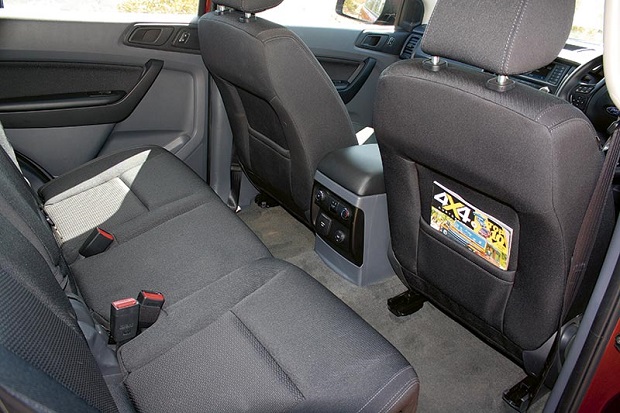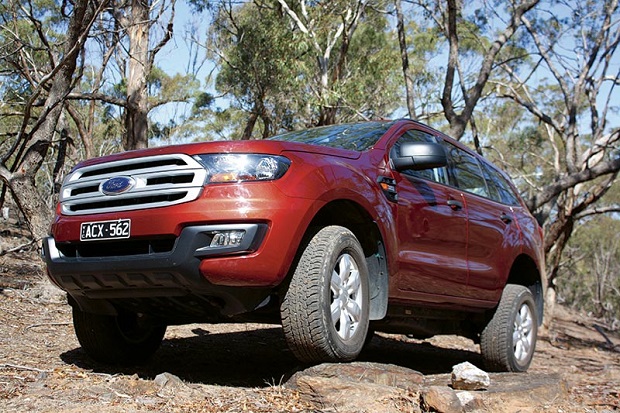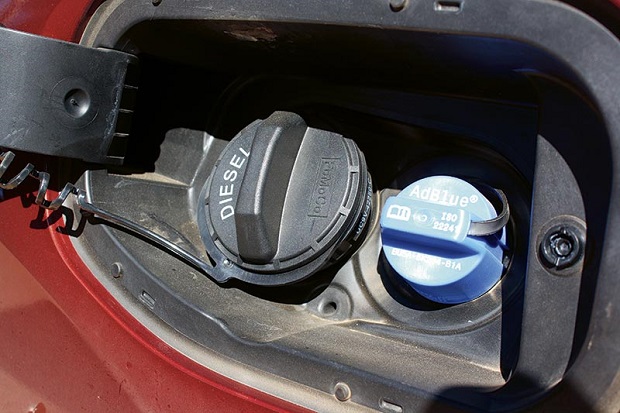The Australian launch of Ford’s new Everest 4x4 has been keenly anticipated. MATT WOOD takes the new SUV for a spin.
Watch the video review
The local launch of the Ford Everest was probably one of the most hotly anticipated new car launches of 2015.
A ladder chassis 4×4 with the rugged good looks of the Ranger that also serves as a family friendly 7-seater.
Australia’s appetite for SUVs is showing no signs of abating. With the rise of the SUV as a family car, it’s fair to say the vast majority of these vehicles will spend their days on metropolitan family truckster duties, and probably the odd trip away.
But it’s clear from a pricing and equipment point of view that Ford is ramping up the sales fight with Toyota. And this baby has the Landcruiser Prado firmly in its sights.
But, does the Everest have what it takes to muscle in on Toyota’s firmly entrenched rural heartland? I thought I’d see how the big Ford handles out in the bush and away from the suburban school run hurly burly.
SEE ALSO: Ford unveils MY2015 Ranger and new Everest SUV
The Everest range
Like the majority of the Ford range, the Everest is available in three levels of spec: the base Ambiente ($54,990), mid-range Trend ($60,990) and the range topping Titanium ($76,990).
The Ambiente gets 18-inch alloys, Sync 1 infotainment system (no navigation) and a cloth interior.
It does still get plenty of standard kit, including cruise control, speed limiter, air-con, fog lamps, hill start assist, reverse camera, auto headlights, TMS, and a full suite of electronic stability controls.
The Trend grows on this by featuring the Sync 2 infotainment system with eight-inch touch screen, adaptive cruise control, a power tailgate, running boards, lane departure warning, a programmable MyKey system that allows vehicle functions and performance to be curtailed for other drivers, daytime running lights, dual zone climate control, auto high beam assist, rain sensing wipers, colour coded roof rails, colour coded mirrors and door handles, a leather trimmed steering wheel, and a chrome grille – amongst other bits and bobs.
The Titanium flagship gets all of the above, but sits on 20-inch alloys and features a leather interior, chrome door handles, a sunroof, sat nav with traffic management, power folding third seat row, power seats, blind spot assist, tyre pressure monitoring system, active park assist and a HID headlamp system featuring a self-levelling function that stops you dazzling oncoming traffic when loaded or towing.
Engine and towing
Engine wise the Everest uses the same 3.2-litre five-cylinder turbo diesel currently found in the upper echelons of the Ranger line-up.
Power is marginally lower at 143kW (as opposed to the Ranger’s 147kW), but torque remains unchanged at 470Nm.
It’s a very torquey engine to operate, and serves the Everest’s Ranger sibling well. And a six-speed automatic tranny keeps the cogs shifting.
Towing is a relatively modest braked 3000kg as opposed to the Ranger’s 3500kg.
Drive
The Everest uses the Ranger platform as its basis, but as it’s destined to be a passenger vehicle, there are some key differences.
The rear axle is sprung with a Watts linkage set up to take away the empty truck jiggle that is a characteristic of most one tonne utes.
The Ford is an all-wheel drive proposition with a rather nifty Terrain Management System that can direct drive to all wheels as needed.
 |
|
The Terrain Management System for off-road is intuitive and easy to use
|
In general driving the system maintains a 60/40 bias in favour of the rear wheels. The system can transfer 100 per cent of power to the rear wheels if required.
The Terrain Management System is a shift on the fly four-wheel drive system that allows you to alter the way power is delivered to all four wheels, as well as adjusting the parameters of the electronic stability program.
The snow and ice selection on the dial is essentially a hi-range four-wheel drive setting, while the sand setting makes the throttle more sensitive and allows for more wheel slip to maintain momentum in sand.
Much to my dismay, the rock mode has nothing to do with the sound system. Rock mode requires 4×4 low range to be selected and switches off the ESP.
Just to enhance the Everest’s off-road credentials, there’s also electronic diff-lock for the rear diff.
There’s also a hill descent control function that allows the big wagon to slither down a slippery slope safely. The speed of the descent is controlled by the steering wheel mounted cruise control buttons.
The Everest will also waddle through 800mm of deep water without choking on a carp. And 225mm of clearance keeps the undercarriage of the SUV out of the weeds.
Cab and controls
My big red car was the base Ambiente, and I reckon as country transport it could fit the bill.
From the outside, the only real downer on the base car is the lack of side steps. Even the lack of shiny bits doesn’t really affect the look of the car too much.
It’s a decent swing up into the big Ford, but once in the seat it’s a comfy place to be.
That said, for a car over $50k, it does feel a little basic and utilitarian inside.
 |
|
Back seat room is generous. The third row is a little squeezy
|
The Everest gets Ford’s Sync 2 infotainment system, which features all the gizmos we’ve come to expect from our vehicles these days: bluetooth phone and audio streaming, voice command function and an emergency assist function.
All models have Electronically Power Assisted Steering (EPAS).
The emergency assist function detects when the airbags have deployed and the fuel pump stops working. It will then automatically call 000 via the phone that is connected to the system.
It’s a nice idea, except it needs phone signal to work, which is not always that prevalent in the Australian back blocks. Should the worst happen, there are seven airbags to soften the blow.
Performance
Flicking the key brings the five-pot diesel to life. The 3.2-litre Duratorq donk is a grunty yet grumbly engine in the Ranger.
However, an electronic noise cancelling function on the Everest smooths out the diesel growl. It takes a fairly hefty boot of acceleration to make the engine sound anything but civilised.
There’s no mistaking that this is a big lump of car. A common question in the lead up to the launch was whether the Everest was a Territory replacement.
But really, the Everest on its full chassis and big dimensions is in another class again. This car weighs in at 2370kg, the full-spec version tips the scales at 2495kg. It’s also a decent 4892mm long.
 |
|
It’s a big car but it sits well on a country road.
|
No doubt this contributes to just how planted the Everest feels on a variety of road surfaces. The suspension tune feels very sorted indeed, whether on the highway, broken asphalt or on dirt.
The 6-speed auto does seem to bog down a little in the first couple of gears, but smooths out as momentum increases.
The EPAS steering system does make the Ford feel nimble in town, however it still feels a little twitchy for my liking on the open road. But more to the point, I’m not a huge fan of the low speed feel of the system when off-road in four-wheel drive mode.
If you’re used to feeling what the front wheels are doing in the rough stuff, it feels a little dead.
The upside is that you aren’t in danger of losing your thumbs from the wheel kicking back while negotiating an obstacle.
AdBlue
One thing that may make some buyers do a double take when popping the fuel filler lid is the AdBlue filler cap nestled in there.
The Duratorq engine in the Everest is a Selective Catalytic Reduction unit to meet emissions regulations.
This may seem like a big deal for those unfamiliar with SCR engines, but there are advantages that stem from an SCR donk.
In fact, many people already own SCR-equipped vehicles without even knowing it. In some European cars, the AdBlue is in a cartridge under the car and is replaced as a service item.
 |
|
The Everest uses AdBlue to meet emissions, though most people will rarely have to top up between services
|
By using SCR, the big Ford doesn’t have to recycle as much exhaust through the engine, which in turn means that operating temperatures within the engine are lower than an Exhaust Gas Recirculation (EGR) engine. It also helps in the fuel efficiency stakes.
In a car like the Everest, which is likely to see big loads and long distances, it’s nice to have the option of topping it up yourself.
The AdBlue tank has a capacity of 18 litres, and projected range under normal driving conditions is between 10,000 and 16,000 kilometres, meaning that many owners will never have to top up between service intervals.
However, heavy towing and off-road use, as well as aggressive driving, can see that range fall to as low as 3000 to 6000 kilometres. If you run out, the engine will de-rate until the tank is topped up.
An instrument cluster mounted warning light illuminates when there’s 800km of range left in the AdBlue tank, which should be more than enough for most folks to get to where they’re going before a top up.
Due to the prevalence of SCR engines in commercial vehicles, AdBlue is now easily found in service stations Australia wide.
Verdict
The Everest is more than capable of eating up country miles with ease. But it also handles itself with aplomb off the beaten track.
I tackled rocks, sand and dry creek crossings, as well as a couple of challenging climbs, and the Ford tackled all of these gamely.
Visibility off-road in such a large vehicle can be a little challenging. But despite its heft, the TMS system proved very effective at getting power to the ground in all manner of situations.
With such a large vehicle, descending a long slope can be a challenge, but the Hill Descent Control system makes that a lot easier by gently braking individual wheels to keep things controlled and upright.
The Everest will no doubt be compared to other ute-based SUVs on the market, such as the Holden Colorado 7, the Isuzu MU-X, Toyota Fortuner and the Mitsubishi Challenger, many of which are 10k cheaper depending on specification. As such, pricing will be an issue.
But as a Prado challenger, the Everest is a worthy foe in terms of pricing, ability and equipment.
Ford will have to work hard to get the runs on the board with the Everest if it’s going to sway country buyers into the big SUV.
Specifications
Ford Everest Ambiente
Engine: 3.2-litre five-cylinder Duratorq diesel
Power: 143kW/470Nm
Transmission: 6-speed automatic
Drive: All-wheel drive with terrain management and two-speed transfer case.
Seating: 7
Towing: 3000kg (braked)


